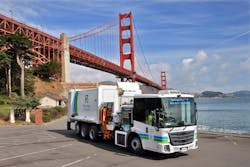Waste and Recycling Company tests Hydrogen Fuel Cell Electric Refuse Vehicle on San Francisco Route
Recology, which provides waste collection and recycling services to more than 2.5 million customers on the U.S. west coast, is now testing a hydrogen fuel cell-electric vehicle developed by Hyzon and New Way Trucks.
The H2-powered refuse collection vehicle is now being piloted on one of the company’s San Francisco area routes. The refuse collection vehicle was built in partnership between New Way Trucks, a refuse truck body manufacturer, and Hyzon, a fuel cell manufacturer and technology developer.
Recology will pilot the electric refuse vehicle in its efforts to reduce waste and use clean energy. The trial in San Francisco tracks with regional leaders' efforts to bring a similar technology to the ferry boats traversing San Francisco Bay every day.
"Considering there are more than 140,000 refuse trucks operating across the market today, waste collection presents an ideal application to showcase the viability of hydrogen fuel cell technology across the environmental services industry," said Eric Evans, Chief Product Officer for New Way, in a statement.
Recology will test the vehicle in other Bay Area cities after piloting the truck in San Francisco. New Way and Hyzon have scheduled additional trials throughout California later in 2024, to be followed by more trials in Canada.
The trial aims to confirm that zero-emission vehicles have the power and range required to complete collection routes and transport heavy loads. Recology serves customers in California, Oregon and Washington.
In decarbonizing the transportation fleet sectors, many hydrogen proponents say that H2 fuel cells offer improved energy density and longer ranges between refueling than battery electric vehicles. They also are not negatively impacted by extreme temperatures or payload limitations, according to reports.
Through its Assembly Bill 8 program, the state of California has co-funded deployment of at least 100 hydrogen fuel cell refueling stations across the state. The legislation provided the California Energy Commission with up to $20 million annually to develop hydrogen fueling stations up through 2023.
Adoption has been slow due to the scarcity of refueling stations, however, and the H2 market sales are only a small percent of the battery electric sales, according to other reports.
Hydrogen does not contain carbon in its molecular chain and thus does not emit carbon dioxide when combusted or consumed. It is only produced commercially through electrolysis or steam reforming of methane gas.
Fuel cell technology uses an electrochemical reaction to convert a fuel into electricity.
About the Author
Rod Walton, EnergyTech Managing Editor
Managing Editor
For EnergyTech editorial inquiries, please contact Managing Editor Rod Walton at [email protected].
Rod Walton has spent 17 years covering the energy industry as a newspaper and trade journalist. He formerly was energy writer and business editor at the Tulsa World. Later, he spent six years covering the electricity power sector for Pennwell and Clarion Events. He joined Endeavor and EnergyTech in November 2021.
Walton earned his Bachelors degree in journalism from the University of Oklahoma. His career stops include the Moore American, Bartlesville Examiner-Enterprise, Wagoner Tribune and Tulsa World.
EnergyTech is focused on the mission critical and large-scale energy users and their sustainability and resiliency goals. These include the commercial and industrial sectors, as well as the military, universities, data centers and microgrids. The C&I sectors together account for close to 30 percent of greenhouse gas emissions in the U.S.
He was named Managing Editor for Microgrid Knowledge and EnergyTech starting July 1, 2023
Many large-scale energy users such as Fortune 500 companies, and mission-critical users such as military bases, universities, healthcare facilities, public safety and data centers, shifting their energy priorities to reach net-zero carbon goals within the coming decades. These include plans for renewable energy power purchase agreements, but also on-site resiliency projects such as microgrids, combined heat and power, rooftop solar, energy storage, digitalization and building efficiency upgrades.

